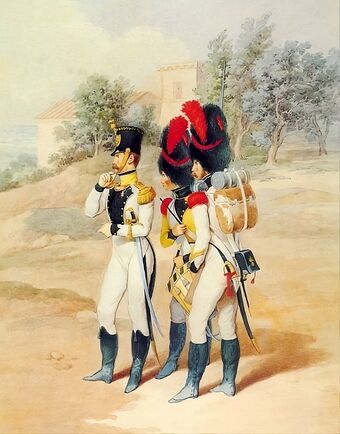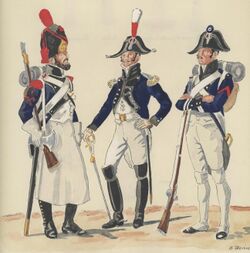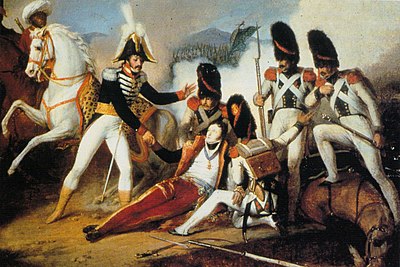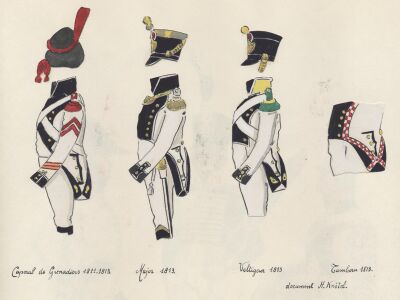3rd Line Infantry Regiment 'Principe Reale'
The 3rd Line Infantry Regiment (In Italian: 3o Reggimento Fanteria di Linea) was one of the line infantry units of the Kingdom of Naples. It was one of the least combat-effective regiments of the Army due to the poor quality of its rankers, suffering from the poor quality of its rankers and dubious combat skill of its officers. It was officially raised during Joseph I’s reign yet not fully constituted until 1809, during the reign of Joachim Murat. The regiment would spend its entire existence fighting across the Apennine Peninsula and hence was never deployed in Spain, Russia or Germany; it was still a generally inexperienced regiment in 1814. Nevertheless, in the Kingdom’s final campaign, it fought with great distinction, scoring a number of battlefield successes under the leadership of its experienced colonel Bernardo Palma. The regiment would be one of the few units to end the campaign relatively intact.
It was given the title “Principe Reale” or Royal Prince’s Own in 1810 as an honorary formality.
Formation
The original formation of the 3rd Line was never officially decreed, but orders were given to Colonel Louis de Gambs (son of the lieutenant general of the same name) to raise a third Neapolitan line infantry unit from deserters and the captured Bourbon garrison of Gaeta in 1806. These few men were merged with the 2nd Line on 17th September 1806, and for the next two and a half years the 3rd Line was non-existent. Only on 10th March 1809, a year into Joachim Murat’s reign, was the reraising of the 3rd Line decreed, and the command of the regiment given to Luigi Arcovito, an experienced officer and patriot. Arcovito had served in the Swedish, Parthenopean, and Bourbon armies and had seen much combat over the years, before being employed in Murat’s army as a Colonel. His expert hand guided the regiment through its early days, drilling its green recruits into trained infantrymen in mere months; by June, the regiment was ready to undertake its first military operation.
Imperial Service
The 3rd Line set off from Gaeta to Rome in June 1809 as part of the Neapolitan occupation force sent to aid the French seizure of the Papal States. This seemingly harmless expedition instantly proved to be problematic for the fragile regiment, as men began to desert from the ranks in droves upon realising that they were invading the Holy See’s territory, fearing divine retribution. Nevertheless, the regiment arrived in Rome and remained garrisoned there for several months. On September 14th Arcovito was reassigned as colonel of the 5th Line, and the command of the regiment went to Giuseppe Rosaroll, another famous Italian patriot. A fiery and energetic character, Rosaroll was already a veteran of Marengo and had also fought in the Parthenopean army during the civil war of 1799. During his brief stay in Rome, he managed to maintain order on the streets and contain the largely hostile populace from rising. However, by early 1810 tensions were rising dangerously high within the city and Rosaroll was forced to call for reinforcements, namely the regiment’s third battalion stationed in Gaeta.
Fortunately, the entire occupation force was recalled back to the Kingdom in February, with the 3rd Line departing Rome on February 19th to reach Capua on the 26th. On March 1st, the regiment was reviewed by Murat on the Chiaia Riviera in Naples, as part of a general military review of all the Franco-Neapolitan troops stationed in and around Naples. At this time the regiment’s strength was around 1800 men.
Service in Calabria
The regiment, under Rosaroll’s command, was present in Calabria from mid-February 1810 and remained there until April 1813. It was first present in Lower Calabria in the invasion force assembled for the landings in Sicily planned to occur that year. Murat, tired of the disastrous naval war against the Anglo-Sicilian fleet, decided to launch the invasion on the night of the 17th of September. The planned force of 10,000 men was never assembled, as General Paul Grenier refused to grant a single French soldier to the King, and hence a half-hearted attack was made composed only of the 2nd Battalion of the Royal Corsican Regiment, six companies of the 2nd Light, and six companies each of the 1/3rd and 1/4th Line. The 3rd Line landed around Santo Stefano, six miles south of Messina, where it found the ground before them crawling with armed peasantry who were soon reinforced by the British 21st Foot and 3rd Battalion Kings German Legion, volleying the hapless Neapolitans and forcing them back to the beach. A stand there proved unsuccessful as the British turned the Neapolitan flank and a general retreat was sounded, in which many of the invasion force were captured. The 3rd Line and 2nd Light escaped relatively unscathed, and managed to return to the other side of the Straight of Messina the next day without losing too many men. The other regiments had suffered great losses, and Colonel D’Ambrosio alongside a number of officers (and the standard of the Corsican regiment) had been captured. The invasion force had suffered some 1,000 total casualties in killed, wounded and captured. Despite the defeat, Rosaroll was given the title of Baron for his bravery in the action.
Following the disaster at Santo Stefano the regiment remained deployed in Lower Calabria to guard the coast and fight brigands. Its men were part of several mobile columns during General Manhes’s repression of brigandage in 1811, and on the 23rd of April the regiment’s command was transferred to Henri Roche, a Frenchman. Roche was a man of dubious military competence and most probably gained his rank as a result of favouritism with Murat. The regiment remained in Calabria and on the 21st of July 1812 some 400 men under Capobattaglione Patrizio were present at Pietrenere, where an armed British demonstration took place. The coastal batteries there consisted of six 36-pounder guns implanted on a hill overlooking the beach; a sizeable British force under Captain Sir Robert Hall was attempting to land there on the morning of the 21st, under the fire of the battery. The British gunboats proceeded to silence the coastal battery and land some 350 men onto the beach, who beat the 3rd Line (deployed on the hill) back and forced it to abandon the guns after a sharp bayonet fight in which the 3rd Line lost several prisoners, including three deserters. While the 3rd Line withdrew and rallied further back, the British proceeded to spike the guns and burn several provision-laden boats, before pulling back to their own vessels.
The engagement ended with the British escaping along with their prisoners and leaving the battery in ruins and Neapolitan morale crumbling. According to the British, four officers and thirty-six privates from the 3rd Line and the coastal battery crew had been taken prisoner. Patrizio had not been captured and was recommended for cashiering, although this never happened. A second engagement occurred at Pietrenere on the night of 14/15th February 1813 and proved even more disastrous:
A strong Anglo-Sicilian force, once again under the command of Sir Robert Hall, set out to attack a large grouping of French boats assembled at Pietrenere on the 14th. Due to bad winds, only a detachment of the 75th Foot was present for the attack on the morning of the 15th. This force, some 150 men of the 75th and a detachment of seamen, proceeded to land at the same spot as that of the previous attack in 1812; they charged up the heights again and there found the 1st Battalion of the 3rd Line with two troops of cavalry and two guns. Roche was there personally to command, and upon being charged by the impetuous British the battalion broke and fled, leaving 163 men and officers prisoner, including Colonel Roche and Capobattaglione Patrizio. The French boats were later burned by the Royal Navy and the British withdrew victoriously again.
Following Roche’s capture, the command of the regiment went to Bernardo Palma, who had previously served in Spain as a battalion chief in both line regiments deployed there. Palma would be the final Colonel of the 3rd Line and would lead the regiment capably until the end of Murat’s regime.
Italian Campaigns of 1814-15
1814 Campaign in Northern Italy
At the end of 1813 the regiment was grouped into General Carlo Filangieri’s brigade of Michele Carrascosa’s first division of the Kingdom’s Army. Filangieri was replaced with Luigi Nicola de Majo in early 1814, and the division united in Reggio on 15th February before setting out for war. The division marched through the Roman States in January, linking with the Austrians in February around Parma and approaching Piacenza on the 16th.
Carrascosa’s Division was present behind Parma when on March 2nd the French under General Grenier attacked FML Laval Nugent’s forces in the city itself; the battle caused a sizeable portion of the Austrian force to end up trapped inside the city and forced to surrender. The retreating Austrians were only allowed to regroup thanks to the deployment of the Neapolitans on the heights behind Parma – in this occasion, the 3rd Line was in the reserve. The Neapolitans withdrew and would next be engaged at Reggio Emilia.
The 3rd Line was among the leading Neapolitan elements approaching the city and deployed in front of the San Nicolò Gate, although it did not advance into the city itself. The French at this point were holed up inside the city, as Colonel Palma had, with great initiative, taken the regiment to occupy the banks of the Naviglio stream, cutting the French line of retreat. This advantageous position was unfortunately not put to use, as an armistice was signed shortly after, enabling the French to withdraw unmolested.
The 3rd Line remained in the second line of Carrascosa’s division and participated in the Battle of the Taro River although was not clearly engaged.
Neapolitan War
Sometime in the period between the two campaigns the command of the 1st Division’s 2nd Brigade was given to Raffaele de Gennaro, a capable officer. Under de Gennaro’s leadership the 3rd Line began the 1815 Campaign, once again grouped in Carrascosa’s division. As the advance guard of the main army, the First Division reached Senigallia first and then proceeded to Pesaro, Cattolica, across the Rubicon and to Rimini, where Murat’s famous proclamation was made. The division entered Bologna on the 2nd of April and on the 3rd the Army was engaged at the Battle of the Panaro, east of Modena.
The 3rd Line initially helped force the Austrians to abandon the right bank of the Panaro; later during the battle, following General Filangieri’s heroic charge, the 2nd Brigade under De Gennaro energetically charged across the bridge once the enemy flank had been turned at Spilamberto and forced the Austrians to withdraw and lose several prisoners. The regiment then remained between Modena, Reggio and Carpi for the next few days, not taking part in the battles of Occhiobello or Carpi. On the 13th the entire division pulled back over the Panaro, occupying the positions it had fought to take earlier that month.
Later that week, the Austrians routed the 1st Line positioned at the ford at Spilamberto and turned the flank of the Neapolitan positions. The division was forced to retreat further back across the Reno, where in front of Bologna they made a stand on the stone bridge there. In the advanced posts was Pepe’s brigade, while de Gennaro’s brigade remained in the reserve. The Austrians, numerous in number, attacked with both infantry and cavalry, forcing Pepe to call reinforcements from both the 3rd Line and 5th Line. The day ended in a Neapolitan victory, as the Austrians failed to dislodge the Neapolitans in the face of sharp musketry. Following the battle, the Commander’s Cross of the Order of Two Sicilies was given to Colonel Palma for his bravery that day.
The division continued to retreat. It continued down the high road and deployed in front of Cesena on the 22nd. No serious combat occurred here as the Austrians failed to attack (they themselves being outnumbered), and the 3rd Line was not engaged in the next few weeks of the retreat. It probably was minorly engaged at the 1st Division’s rear-guard action at Pesaro and pulled back south with the rest of Carrascosa’s force. The division was not engaged at the decisive battle at Tolentino and was forced to retreat with the rest of the Army south towards Capua and Naples. The Austrians caught up with the rear-guard at Castel di Sangro, thirty miles from Campobasso; here, Carrascosa deployed his division in order of battle on the main road and feigned a retreat. Then, turning about in the right moment, Carrascosa personally advanced at the head of the 3rd Line (and two elite companies of the 5th) against the Austrian N.5 Radetzky Hussars that were threatening the centre of the line. The regiment formed into battalion squares and repulsed a charge by the Austrian hussars; the 3rd Line then deployed in line to repulse an Austrian infantry attack on the right of the line. This was achieved with great success, and the Austrian regiment was forced to pull back in disorder, ending the action. Carrascosa pulled back after the battle after receiving orders from Murat to continue south. Among others, Colonel Palma was singled out for bravery and even mentioned in the Monitore Napoletano (the state newspaper's) report on the action.
Thus ended the last combat action of the 3rd Line. Like the rest of the army, it reached Capua on the 18th of May and generally ceased to exist after the signing of the Treaty of Casalanza. The majority of the men deserted rather than being employed in Austrian service, while the rest remained garrisoned in the fortress of Capua.
Like in the other line regiments, many officers remained in Bourbon service, including Colonel Bernardo Palma, who continued to lead regiments until the end of his military career.
Uniform
For reasons that remain unclear to this day, the first uniform issued to the 3rd Line Regiment varied significantly from that of the previous two line infantry regiments. Rather than being equipped with the standard white habit-veste, the 3rd was issued a dark blue coat with flapped cuffs. It is unclear whether this jacket was of the same cut as the earlier white variant, or it had a more modern cut with shorter coattails and vertical pockets. It is also possible that the flapped cuffs resulted in the addition of an extra button.
While the exact reason for this change remains unclear, historian Piero Crociani speculates that this could have been a result of the reintroduction of blue cloth in the French line infantry’s uniforms. The regimental facing colour was decreed as black, and this remained the regiment’s distinctive colour for its entire existence. The headgear and equipment remained the same as for the rest of the line regiments.
For simplicity, the table below depicts the 3rd Line’s jacket as of the modern 1806 design with shorter coattails.
1806-1811 Uniform
| Detail | Description |
|---|---|
| Headgear | French style bicorne for all companies; pompom colour based on company (Green, Blue, Orange, Violet respectively)
Grenadiers also equipped with French-style bearskins with red chords, plume and back patch, bearing a single yellow grenade insignia patch |
| Neckstock | Black |
| Coat | Dark blue, French cut, flapped cuffs, black facings
Collar black with white piping Lapels black Pockets vertical; dark blue with black piping Cuffs black with white piping, three (?) brass buttons Coattails short; dark blue with black piping, grenade/bugle insignia for grenadiers and voltigeurs respectively |
| Epaulettes | Fusiliers white shoulder-straps piped light blue
Grenadiers red fringe epaulettes Voltigeurs green fringe epaulettes |
| Waistcoat | White; 9 equally spaced brass golden buttons, black cuffs and collar |
| Breeches | White |
| Gaiters | Black |
| Equipment | Bandoliers White; one for Fusiliers and Voltigeurs, two for Grenadiers
Waistbelt n/a Cartridge Box Black, Insignia N/A Fatigue Cap No visual nor written evidence, although the author speculates it is dark blue with black lining; red company insignia for elite companies Footgear regular French infantry cowhide shoes, 36-40 nails depending on size |
1811 Uniform
Following the release of the 1811 uniform regulations, the regiment was equipped with the modernised white habit-veste and revamped headgear.
| Detail | Description |
|---|---|
| Headgear | Fusiliers French style black felt shako with brass plate bearing regimental number (3) or royal cypher, pompom colour based on company (Green, Blue, Orange, Violet respectively)
Grenadiers French style black felt shako with brass plate bearing a grenade, red pompom Bearskins (as mentioned above) also in use Voltigeurs French style black felt shako with brass plate bearing grenade over a horn with regimental number (2), green pompom |
| Neckstock | Black |
| Coat | White, French cut, cuff flaps, black facings, two rows of 7 buttons
Collar black with white piping Lapels black Pockets white with black piping Cuffs pointed, black with white piping, two brass buttons Coattails short; white with black piping, grenade/bugle insignia for grenadiers and voltigeurs respectively |
| Epaulettes | Fusiliers white shoulder-straps piped black
Grenadiers red fringe epaulettes Voltigeurs green fringe epaulettes |
| Waistcoat | White; 9 equally spaced brass golden buttons, black cuffs and collar |
| Breeches | White |
| Gaiters | Black |
| Equipment | Bandoliers White; one for Fusiliers and Voltigeurs, two for Grenadiers
Waistbelt n/a Cartridge Box Black, Insignia N/A Fatigue Cap White with black lining; black company insignia for elite companies Footgear regular French infantry cowhide shoes, 36-40 nails depending on size |
Colours
Owing to the regiment’s late formation, it missed Joseph’s reign and hence was never given the 1806-pattern colours. The regiment probably had tailor-made battalion fanions, and the actual regimental standard was issued on 15th February 1811. The flag consisted of a white and amaranth checkerboard square on a light blue background, alongside a gold inscription on the obverse and the Kingdom’s lesser arms on the reverse. It is probable that the regiment took the flags on campaign in 1814-15, as depicted in contemporary prints of Neapolitan troops.
1810-Pattern Drapeau:
- Field: blue
- Red and Amaranth checkerboard surrounding
- Obverse (right): Green laurel/holly wreath topped with “GN” and crown; inscription “Al/REGGto/D’Infanteria/3o Di Linea
- Reverse (left): Shield of the lesser arms of the Kingdom of Naples under Joachim Murat alongside two mermaids, a royal crown of five hoops and the Order of Two Sicilies.
List of Colonels
| Date Appointed | Name |
|---|---|
| 18th March 1809 | Luigi Arcovito |
| 15th September 1809 | Giuseppe Rosaroll |
| 23rd April 1812 | Henri Roche |
| 12th April 1813 | Bernardo Palma |








